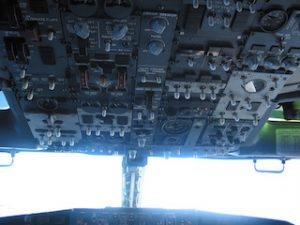Critical Components Of Pilot Weather Briefings
 When it comes to aviation safety, few factors are as important as understanding and interpreting weather conditions. Whether flying a commercial airliner, a private plane, or a cargo jet, pilots rely on up-to-the-minute weather data to make informed decisions that ensure the safety of their passengers, crew, and aircraft. One of the most critical processes that pilots engage in before taking to the skies is the weather briefing. This briefing is the foundation for assessing the flying conditions for any given flight, and it plays an indispensable role in aviation safety.
When it comes to aviation safety, few factors are as important as understanding and interpreting weather conditions. Whether flying a commercial airliner, a private plane, or a cargo jet, pilots rely on up-to-the-minute weather data to make informed decisions that ensure the safety of their passengers, crew, and aircraft. One of the most critical processes that pilots engage in before taking to the skies is the weather briefing. This briefing is the foundation for assessing the flying conditions for any given flight, and it plays an indispensable role in aviation safety.
A pilot weather briefing involves gathering detailed and accurate weather information relevant to a particular flight. It typically includes current weather conditions, forecasts, and any hazardous phenomena like storms, turbulence, or low visibility that may affect the flight’s trajectory. Pilots use weather briefings to help plan their flight routes, adjust for potential weather-related disruptions, and make real-time decisions in-flight. With advancements in meteorological technology, pilots now have access to more comprehensive and real-time data than ever before.
This article explores the critical components of a pilot weather briefing, how pilots utilize weather information, and how these briefings enhance flight safety. By the end, you will gain a deeper understanding of how essential weather data is for aviation and how a detailed weather briefing contributes to the overall safety and success of a flight.
Importance of weather in aviation
Weather has always been the most unpredictable and potentially dangerous factor in aviation. Pilots, air traffic controllers, and meteorologists work in tandem to ensure that accurate weather data is available, interpreted, and acted upon to mitigate any weather-related risks. Adverse weather conditions, such as thunderstorms, fog, ice, turbulence, and high winds, can present serious challenges during takeoff, en route flight, and landing.
A well-executed pilot weather briefing allows pilots to anticipate and avoid hazardous weather conditions. For example, knowing the location of severe thunderstorms along the flight path can help pilots reroute to avoid turbulence, while forecasting low visibility at the destination airport helps pilots prepare for potential delays or diversions.
Weather also affects flight planning and fuel calculations. For instance, headwinds can increase fuel consumption, while favorable tailwinds can reduce flight time and save fuel. Therefore, pilots must gather accurate weather data before and during their flights to make optimal decisions.
What is a pilot weather briefing?
Pilot weather briefing is the process of gathering and interpreting weather data pertinent to a specific flight. This briefing is typically conducted before the flight and can be requested from various sources, including meteorological offices, aviation weather services, or flight planning tools. The briefing includes a broad spectrum of weather information, ranging from current conditions to forecasts, weather hazards, and special notices that might affect the safety of the flight.
For commercial airline pilots, the weather briefing is an integral part of the pre-flight process. However, the level of detail and type of briefing may vary depending on the flight’s length, location, and specific needs. For instance, a domestic short-haul flight may only require a basic weather overview, while long-haul international flights demand more detailed analysis due to the complex nature of weather patterns across vast distances.
In general, there are 2 types of weather briefings that pilots typically use:
- Standard weather briefing: This is a comprehensive weather report covering all pertinent weather conditions, including current weather, forecasts, warnings, and any other relevant information for the flight’s planned route.
- Abbreviated weather briefing: This is a more concise version of the standard briefing, used when a pilot only needs a quick update on weather conditions due to time constraints or when the pilot has already gathered most of the necessary information.
Weather briefings come in the form of text-based reports, weather charts, and visual maps. These documents are derived from a variety of sources, including weather satellites, radar systems, weather stations, and high-altitude reconnaissance aircraft. Additionally, automated weather systems such as METAR and TAF provide frequent, standardised reports that pilots can use for real-time decision-making.
Key components of a weather briefing
A comprehensive weather briefing involves a wide range of weather-related data, each critical for the safety and success of the flight. Pilots must assess several factors, from wind patterns and visibility to temperature and precipitation, to develop a clear picture of what to expect throughout the flight. Below are the primary components of a typical weather briefing:
Current weather conditions
The 1st piece of information a pilot receives in a weather briefing is the current weather conditions at the departure and destination airports, as well as along the flight route. This includes data on:
-
- Wind speed and direction: Strong crosswinds or gusty winds at the airport can affect takeoff and landing, while headwinds or tailwinds during the flight will impact fuel efficiency and flight time.
- Temperature and pressure: These factors help determine the aircraft’s performance, including engine power, fuel burn, and overall lift.
- Precipitation: Rain, snow, or thunderstorms can reduce visibility and create hazardous conditions, especially during takeoff and landing.
- Cloud cover and visibility: Low visibility, often caused by fog, low clouds, or heavy precipitation, may affect navigation and require the use of instrument-based approaches.
For example, if a pilot is departing from an airport with strong crosswinds, the weather briefing will help them determine whether it is safe to take off or if alternative procedures or runway changes are necessary. Similarly, low visibility forecasts can alert the pilot to the need for instrument approaches during landing.
Weather hazards and warnings
Weather-related hazards are a significant part of a pilot weather briefing. These warnings and advisories help pilots avoid dangerous conditions that may arise before or during the flight. Such warnings include:
-
- Thunderstorms: Thunderstorms are one of the most hazardous weather phenomena for pilots. They can bring severe turbulence, lightning, hail, and rapid changes in wind direction and speed. Pilot weather briefings provide real-time updates on thunderstorm locations and intensity.
- Icing conditions: Ice can form on aircraft surfaces, especially at high altitudes or in cold, moist air. Weather briefings highlight areas of known or forecasted icing conditions, allowing pilots to plan for altitude changes or to alter their flight route to avoid these dangerous zones.
- Turbulence: Weather briefings also provide information on expected turbulence, whether caused by thunderstorms, wind shear, or other atmospheric conditions. Pilots can use this data to adjust their flight altitude or speed to minimise the discomfort and risks associated with turbulence.
- Volcanic ash or other disruptions: Certain geographic regions are vulnerable to volcanic ash clouds, which can pose a significant risk to aircraft engines and flight safety. Pilots receive alerts regarding such disruptions through weather briefings.
Weather warnings help pilots make timely decisions about altering their route, diverting the flight, or taking other preventive measures.
Flight route forecasts
A weather briefing includes detailed forecasts for the entire flight route, including en-route and alternate airports. These forecasts include winds aloft data, temperature variations, and the likelihood of turbulence, as well as the position of any severe weather systems along the route. For long flights, pilots rely on accurate route forecasts to adjust for wind patterns that could impact fuel consumption or flight time.
For instance, strong headwinds might prompt the pilot to adjust the flight altitude to a more favorable wind layer or alter the flight path to save fuel. Conversely, if favourable tailwinds are forecasted, pilots may optimise the route to take advantage of these conditions, saving time and reducing fuel burn.
METAR and TAF reports
Two of the most important weather tools for pilots are METAR and TAF reports, both of which are integral components of a weather briefing.
-
- METAR: This is a standard aviation weather report that provides real-time information on weather conditions at a specific airport. It includes data on temperature, wind speed and direction, visibility, cloud cover, and significant weather events like precipitation or fog. METAR reports are issued every hour, providing up-to-date information for pilots.
- TAF: Unlike the METAR, which reports current conditions, the TAF provides forecasted weather information for a specific airport, typically for a 24-hour period. It includes predictions on visibility, wind, temperature, and other key factors like precipitation or fog that might affect flight operations.
These reports are essential for making quick decisions regarding flight delays, route changes, and alternate airport planning.
Alternate airports
In the event of adverse weather at the destination airport or along the flight route, pilots need to plan for alternate airports. A weather briefing provides detailed information on the weather conditions at nearby airports, including visibility, wind conditions, and potential hazards, allowing pilots to decide if an alternative airport should be used in the event of an emergency landing or diversion.
Real-time weather data during flight
While pre-flight weather briefings are critical, pilots also rely on real-time weather data throughout the flight. Modern aircraft are equipped with weather radar systems, satellite-based tracking tools, and communication systems that allow pilots to access live weather updates during their journey. These systems provide updates on changing weather patterns, giving pilots the opportunity to adjust the flight path, altitude, or speed based on real-time information.
This dynamic process ensures that pilots can adapt to weather changes, such as encountering turbulence, thunderstorms, or changes in visibility. Weather tracking tools on the aircraft, combined with up-to-the-minute updates from air traffic control and meteorological authorities, allow pilots to make the best decisions to ensure a safe and smooth flight.
Critical role of weather briefings in aviation safety
Pilot weather briefing is an essential part of flight planning, helping pilots understand the weather conditions they may encounter before, during, and after the flight. Through weather briefings, pilots can access vital information on current weather, forecasts, hazards, and warnings, allowing them to make informed decisions about their flight route, altitude, and approach. This data not only enhances safety but also supports operational efficiency by optimizing fuel consumption, reducing delays, and mitigating the risks associated with hazardous weather phenomena.
As technology continues to improve, pilots will have access to even more detailed and real-time weather data, further enhancing their ability to navigate the skies safely. The role of weather in aviation will remain a critical element of flight safety, and weather briefings will continue to be an indispensable tool in the pilot’s decision-making process.










